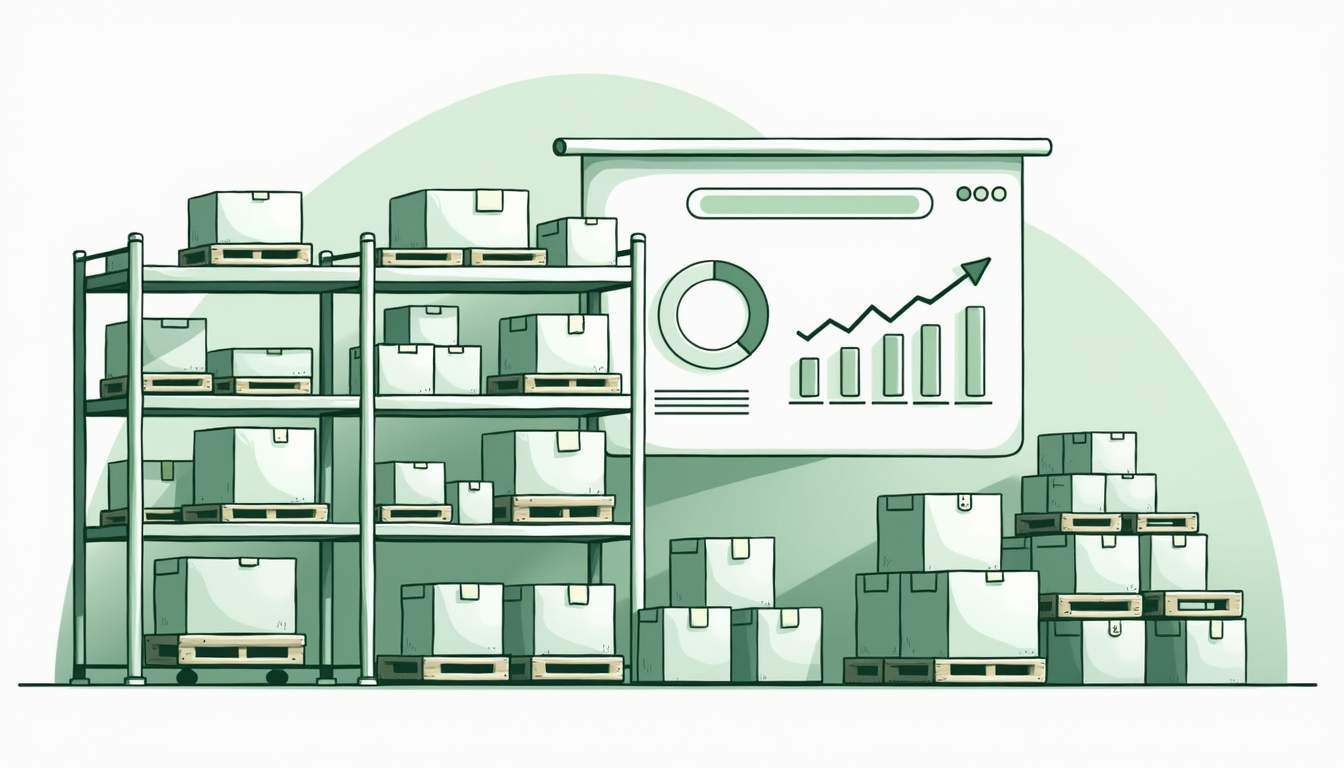Share this
Evaluate Inventory Management Solutions for Ecommerce with Confidence
by Shipfusion Team on Apr. 18, 2025

As ecommerce businesses grow, so does the complexity of tracking inventory across sales channels, warehouses, and customer touchpoints. Effective inventory management starts with avoiding stockouts or overstocking and extends to aligning inventory movement with demand, fulfillment capacity, and cash flow. Inventory management solutions like software – specifically 3PL-grade software – make the biggest difference. This article breaks down features and strategies to help you choose the right arrangement for control amidst changing needs.
What Inventory Management Solutions for Ecommerce Actually Do
Inventory management covers the movement of goods from suppliers to your fulfillment centers and ultimately to your customers. But that definition doesn’t capture its operational depth. A strong system governs:
-
Inbound logistics: Receiving and storing products efficiently
-
Stock accuracy: Maintaining real-time visibility across SKUs and locations
-
Reorder logic: Automating replenishment to match actual sales velocity
-
Demand forecasting: Anticipating trends and aligning stock to future needs
-
Data reporting: Measuring performance, turnover, and supplier reliability
For ecommerce brands working with 3PLs like Shipfusion, inventory management isn’t sold as software but rather embedded into the service. The advantage is having inventory oversight fully tied to fulfillment, meaning fewer data silos and more actionable insights at every stage.
Why Inventory Management Solutions for Ecommerce are Key to Success
For digital-first brands, poor inventory management has direct downstream effects, from order delays and canceled purchases to eroded trust and increased operational costs. Effective systems contribute to:
-
Fewer Stockouts and Backorders: Real-time visibility ensures SKUs don’t run dry unnoticed. Customers get what they ordered on time and without surprises.
-
Lower Holding Costs: Accurate forecasting and reorder automation reduce excess inventory sitting idle on shelves, freeing up capital and storage space.
-
Better Supplier Management: Historical data tied to SKU movement helps pinpoint which suppliers consistently meet timelines and which disrupt fulfillment.
-
Smarter Growth Planning: Brands using fulfillment partners like Shipfusion gain access to real-time reporting on product velocity and seasonal trends, making it easier to time campaigns or launch new lines with inventory to match.
What to Look for In Inventory Management Solutions for Ecommerce
Not every tool fits every brand. What matters is choosing a system that connects cleanly with your sales channels and provides visibility into the metrics you need most. These are the features that should be non-negotiable for ecommerce businesses:
1. Real-Time Inventory Tracking
Systems should sync inventory across platforms (Shopify, Amazon, retail POS) and reflect real-time changes as orders are placed, returns are processed, and replenishment happens. This single source of truth minimizes overselling and reduces customer service friction.
With Shipfusion, this functionality is native – inventory levels update dynamically as fulfillment happens, with visibility across every connected warehouse.
2. Automated Reordering Logic
Static reorder points don’t cut it when demand fluctuates. The best systems allow dynamic reorder thresholds based on SKU velocity, lead times, and safety stock buffers. That way, high-performing SKUs are always in stock without overcommitting capital.
3PLs like Shipfusion handle reordering through rules and triggers tied to forecast models, not just fixed thresholds, reducing the risk of missed revenue due to manual lag.
3. Multi-Location Inventory Visibility
Ecommerce brands operating across multiple fulfillment centers or those considering a 3PL partner need to track where each SKU is located and route orders accordingly. This enables zone-based shipping, improves delivery speed, and reduces costs.
4. Advanced Reporting and Forecasting
Remember, you’re not just looking for inventory counts. You need trend analysis, seasonality insights, turnover reports, and supplier lead time metrics. These data points drive better purchasing decisions and prevent overstock issues during slow months.
Shipfusion’s in-house software provides these insights as part of its managed service, giving clients access to fulfillment-linked reporting without requiring separate analytics tools.
Top Inventory Management Solutions for Ecommerce In 2025
Whether you're managing fulfillment in-house or evaluating 3PL partners, these platforms are frequently used by ecommerce brands looking for more control over their inventory operations.
1. Shipfusion (Inventory Management as a Service)
Shipfusion offers inventory management as a fully integrated part of its 3PL fulfillment service, eliminating the need to purchase or integrate separate software. Instead of relying on third-party tools, brands gain real-time visibility into inventory across multiple warehouse locations through Shipfusion’s proprietary platform. Features include automated replenishment logic, lot and batch tracking, and customizable reporting dashboards.
What sets Shipfusion apart is its hands-on service model. Every client works with a dedicated Account Manager to interpret inventory trends, plan for demand shifts, and troubleshoot potential issues before they impact fulfillment. Because Shipfusion owns both the tech and the physical fulfillment infrastructure, brands benefit from a tightly connected system that minimizes errors and improves operational efficiency at scale.
2. QuickBooks Commerce (formerly TradeGecko)
Ideal for small to mid-sized businesses, QuickBooks Commerce simplifies multi-channel inventory tracking with a user-friendly interface. Best suited for brands already using QuickBooks for accounting, it offers:
-
Inventory visibility across sales channels
-
Basic order and supplier management
-
Integration with platforms like Shopify and WooCommerce
3. Cin7
Cin7 caters to more complex inventory environments by combining inventory, POS, and supply chain tools in one platform. It’s suited for ecommerce brands with wholesale arms or hybrid DTC/B2B models.
-
Built-in EDI for vendor integration
-
Comprehensive reporting tools
-
Automated workflows and custom alerts
4. Skubana
Designed for high-volume ecommerce businesses, Skubana acts as a backend operations platform that connects inventory, order routing, and analytics.
-
Supports complex fulfillment workflows
-
Robust automation for multi-channel selling
-
Real-time inventory and order syncing
These platforms are best for brands managing fulfillment in-house or working with 3PLs that allow clients to bring their own software. However, 3PLs like Shipfusion offer an alternative model: inventory management baked into their fulfillment tech, removing the need for separate licenses or third-party syncing.
How to Choose the Right Inventory Management Solution for Ecommerce
There’s no universal answer, but the right decision comes down to how your business handles fulfillment:
-
If you're fulfilling in-house, you’ll likely need a platform with integrations, automation, and reporting to keep operations lean.
-
If you work with a full-service 3PL, evaluate what kind of inventory management visibility they provide. Some offer basic portals; others, like Shipfusion, provide real-time reporting, automated replenishment logic, and lot tracking, all included in the service.
-
If you're scaling quickly, prioritize systems or partners that support rapid onboarding of new SKUs, locations, or marketplaces, without requiring a full IT rebuild each time.
Shipfusion Is #1 Among the Best Inventory Management Solutions for Ecommerce
With Shipfusion, you can seamlessly integrate top-tier inventory management into your ecommerce strategy. As the leading 3PL fulfillment partner for ecommerce brands, we offer comprehensive services that cover everything from order processing to shipping and returns. Our real-time technology ensures you stay ahead of the game as your business grows. For competitive shipping rates and a fulfillment process that guarantees accuracy and timeliness,
Get pricing today and let Shipfusion propel your ecommerce success.
Share this
You May Also Like
These Related Articles

Inventory Insurance: Why It Matters for Your Business

How to Calculate the Reorder Point Formula for Ecommerce

Complete Ecommerce Inventory Financing Guide For 2024
- April 2025 (19)
- March 2025 (26)
- February 2025 (26)
- January 2025 (37)
- December 2024 (16)
- November 2024 (23)
- October 2024 (22)
- September 2024 (27)
- August 2024 (9)
- July 2024 (8)
- June 2024 (5)
- May 2024 (8)
- April 2024 (8)
- March 2024 (6)
- February 2024 (6)
- January 2024 (5)
- December 2023 (3)
- November 2023 (3)
- October 2023 (5)
- September 2023 (4)
- August 2023 (2)
- July 2023 (1)
- June 2023 (4)
- March 2023 (2)
- October 2022 (1)
- September 2022 (5)
- August 2022 (4)
- July 2022 (7)
- June 2022 (4)
- May 2022 (4)
- April 2022 (6)
- March 2022 (2)
- February 2022 (1)
- January 2022 (3)
- December 2021 (2)
- November 2021 (4)
- October 2021 (2)
- September 2021 (5)
- August 2021 (4)
- July 2021 (4)
- June 2021 (3)
- May 2021 (2)
- April 2021 (3)
- March 2021 (3)
- February 2021 (3)
- January 2021 (2)
- December 2020 (4)
- November 2020 (2)
- October 2020 (4)
- September 2020 (2)
- July 2020 (5)
- June 2020 (4)
- May 2020 (2)
- April 2020 (2)
- March 2020 (4)
- February 2020 (1)
- December 2019 (1)
- May 2018 (1)
- March 2018 (2)
- February 2018 (3)
- January 2018 (3)
- November 2017 (3)
- July 2017 (4)
- March 2017 (3)
- February 2017 (5)
- January 2017 (3)
- December 2016 (4)
- November 2016 (6)
- October 2016 (6)
- October 2015 (1)
- September 2015 (1)
- June 2015 (3)
- May 2015 (3)
- August 2014 (1)
- July 2014 (1)
- March 2014 (1)
- February 2014 (1)